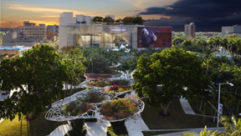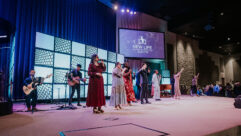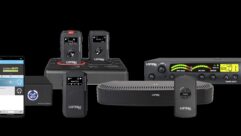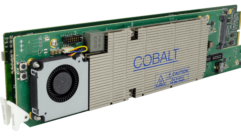New Sounds for a Miami Institution
Feb 1, 2002 12:00 PM,
Bruce Borgerson
The Orange Bowl college football classic abandoned its eponymous stadium in 1996 and followed the Miami Dolphins northward to the new Pro Player Stadium. Still, the illustrious Orange Bowl — now more than 64 years old — remains a popular venue for large outdoor rock concerts, international soccer competitions and a variety of community events. And on a half-dozen Saturday afternoons between September and December, the focus returns to football. Thanks to its ample seating capacity — more than 74,000 — and its proximity to the University of Miami’s Coconut Grove campus, the Orange Bowl remains the home field for the school’s powerhouse Hurricane football team, winners of the 2001 NCAA championship.
The Bowl is owned by the City of Miami, but, as part of a long-term use agreement, the University of Miami has taken over ownership and maintenance of the scoreboard and public address system. The Orange Bowl had benefited from a number of expansions and upgrades over the years, but since the departure of the Dolphins, the scoreboard and its attendant main audio cluster had been neglected. The university’s athletic department was painfully aware of the deterioration: The scoreboard’s appearance was worn and dated, and the sound was unintelligible in many seats.
NEW SYSTEM ON A FAST TRACK
at the end of the 2000 football season, UM’s assistant athletic director for facilities, Stephen Nebrat, sought bids for repairs and upgrades of the scoreboard. When suppliers responded with unexpectedly high, 6-figure estimates, Nebrat and other key department officials decided to junk the old scoreboard and cluster entirely and start from scratch. In late spring, bids were solicited for a new scoreboard, and potential sound system suppliers were contacted several weeks later. After considering two proposals, the university assigned the sound system contract to Pro Sound of Miami, Florida.
“This was a fast-track project,” noted R.J. Coleman, a senior system engineer at Pro Sound and principal designer for the Orange Bowl project. “We had only the midsummer to design the system and get all the equipment ordered and prepped. The last few days promised to be hectic, since steel supports for the cluster cage wouldn’t be up until the week before the opening game on September 8.”
The requirements set forth by the university encompassed the main loudspeaker cluster atop the scoreboard — including all requisite amplification and drive processing — as well as ancillary items such as a new console, playback decks and microphones. (Replacement of the aging distributed system for coverage under the top deck was not included.) The bid documents stipulated a system able to supply (a) significantly improved intelligibility in all parts of the stadium, (b) frequency response and dynamic range suitable for music playback, and (c) minimal mid- and high-frequency sound bleed onto the playing field.
Another preference UM expressed was a relative reduction in the size of the cluster enclosure. The old large-format horns were quite bulky, and Miami’s strict hurricane ordinances limited the allowable exposed footprint of the scoreboard structure.
Designing the Loudspeaker System
When the parameters of the job became clear, Coleman began work on a system design that was a variation of an approach he had successfully used at Tampa Bay’s Raymond James Stadium and, more recently, at Ohio State’s Buckeye Stadium. At the core of the proposal would be a cluster of Meyer Sound self-powered loudspeakers, with the SB-1 parabolic Sound Beam as the principal long-throw device. There were two key differences in the Orange Bowl project, however. With the other two stadium jobs, Pro Sound had followed initial designs from a consulting firm, WJHW of Dallas, and the time frame encompassed many months. This job, however, was a design/build contract, and the design phase had to be completed in a matter of a few weeks.
“Luckily, I was familiar with the Meyer products and knew I would have the necessary power and a smooth response,” Coleman recalled. “Also, this was outdoors in a bowl, and I didn’t have to worry so much about reflections. So, I was able to effectively project the coverage patterns on the seating areas and predict where the 6dB down points would fall.”
Coleman’s final proposal required 11 self-powered Meyer systems to cover the 31, 946 square feet of the Orange Bowl: four MSL-6 horn-loaded high-Q main loudspeakers, four DS-4P horn-loaded mid-bass loudspeakers, and three SB-1 parabolic long-throw Sound Beams. The tight 10° coverage pattern of the SB-1 proved a perfect match for the distances and dimensions involved. “The three Sound Beams are covering seats at the far end of the stadium, between 600 and 700 feet away,” Coleman noted. “The pattern fit almost perfectly, with the 6dB down points hitting the first rows and the very top seats in the bleachers, and almost nothing going on the field or outside the stadium.”
The Meyer systems are arrayed in a straight line inside a metal enclosure measuring 7 feet high and deep and 56 feet long. The speakers are weather-protected on the tops and sides, and the fronts are covered by a perforated grille bearing the Orange Bowl logo. Two MSL-6s on each end are splayed at 30° and 60° to cover the long sides of the bowl, with the three SB-1s and a tight pack of DS-4Ps aimed at the far end of the field. All the loudspeakers were equipped with Meyer Sound’s Remote Monitoring System module for PC-based monitoring and individual muting from the audio booth.
“Ideally, we would have put all three Sound Beams together in the middle,” Coleman remarked, “but the enclosure was built in two sections with a 6-inch steel beam at dead center. That beam would have interfered with the coherent wavefronts of the SB-1s, so we put the DS-4P pack in the middle and split the SB-1s, two to one side and one to the other.”
Digital Signal Processing
For signal distribution and processing, Coleman selected Yamaha‘s DME-32 digital mixing engine. One of the new generation of computer-controlled, do-it-all devices, the DME-32, combines a powerful 32-bit DSP engine (with 24-bit AD/DA conversion), flexible signal routing and PC-based control software to allow custom configuration for a variety of applications. In this case, the DME-32 is used for signal distribution, equalization, frequency division and system delay.
“This was another perfect fit for this job,” said Coleman. “I could customize this one box to do the job by using one input card and three output cards to get my 8×12 configuration, leaving me one output as a spare. Other units with eight fixed outputs would have required using two separate units, at a higher cost.”
Installed in the now practically empty former amplifier room below the scoreboard, the DME-32 accepts a line feed from the control booth. Two inputs are used, one from the digital fiber optic feed, the other for backup copper analog. The DME-32 then distributes signals to the 11 Meyer loudspeakers through a 12-pair cable. The frequency-dividing function serves as a pre-crossover to the Meyer units, which have their own internal filter networks. The delay functions allow temporal alignment of the linear array to approximate a curved point-source cluster, while the parametric EQ functions were used to tweak the system during the SIM System II alignment process.
A High-End Front End
Following the ancient caveat of “garbage in, garbage out,” Coleman’s system specification incorporated a number of front-end upgrades, including a new digital mixing console, new field and referee microphones and new music playback decks.
At the heart of the refurbished control booth is a new Yamaha O1V digital mixing console. With 16 analog and eight digital inputs, four assignable analog outputs, and a number of preset programming features, the O1V provides the flexibility to serve a variety of events.
“The great thing about this console in this type of application is [its] ability to create presets for specific functions,” said Coleman. “Our staff’s Sean Miller installed it and then set up a preset specifically for the Hurricane football games, with pushbutton recall of everything from dynamic control on the referee mic to aux send assignments, gain settings and mic EQ. So, no matter what anybody does between games or in the off season, they press a button, and they’re back exactly where they left off.”
Pro Sound also supplied a modest complement of new microphones, including a wired Shure SM58 and a Telex wireless system comprised of an HT450 handheld transmitter, a WT450 beltpack transmitter, an AD450 antenna distribution unit and a pair of FMR450 receivers. For the referee’s microphone, Coleman selected the Countryman Isomax headset.
“It has a very warm sound, and if you put the pop filter on, it alleviates the wind noise. But the big advantage compared to a lavalier is that when the ref moves his head to the left or right, it doesn’t change proximity to the capsule, so you get more consistent sound.”
Other upgrades in the audio booth included a Tascam CD305 CD changer, a Tascam 102MK2 cassette deck and a custom press feed box with Jensen isolation transformers. SurgeX SXN1240 and SXN240 units provide system-wide power protection. All the booth upgrades were accomplished on a relatively leisurely schedule over the summer months.
Installed and Aligned in Record Time
Installation of the main audio cluster turned out to be, as expected, the classic late-night, last-minute crunch job. “At the end, everything went very fast,” Coleman recalled. “The steel for the scoreboard mounting went up on the Monday before the Saturday game, so everything had to be done in that final week. The great thing about the Meyer cluster is that it flew very fast. We set the systems on the deck, got out our protractor to set the angles, aimed the SB-1s using the transit provided by Meyer, and locked it down to the unistrut. All we had to do for wiring was run audio pairs up from the DME-32 and plug them in, along with the twisted pair for the RMS network. By the time they had power up to us on Thursday, we were ready to go.”
With less than 48 hours before show time, the system was fired up for a basic function check and then turned over to Kelly Prince, a design engineer from Pro Sound’s Orlando office, for final alignment using Meyer Sound’s SIM System II.
“It rained that Friday morning before the game, so we didn’t really get started until about three in the afternoon,” recalled Prince. “We set up the multichannel SIM System in the equipment room beside the DME-32, ran a long snake out on the field and then a whole bunch of XLR cables from there into the stands. We used eight microphones for each section, and we checked both the upper and lower parts of the bowl. That meant a lot of climbing up and down stairs!”
Working with an assistant, Pro Sound technician Sean Miller, Prince first used the SIM System to do final aiming of the high-Q Meyer systems, none of which required adjustments of more than 4 or 5 inches. Prince then proceeded to fine-tune the equalization using the filters in the DME-32.
“Considering the scale of the job, it all went pretty quickly,” Prince said. “This was my first time using the DME-32, but I had a lot of experience with MediaMatrix, and I found it easy to make the transition. Also, it was mostly minor tweaks since, overall, the Meyer loudspeakers are very accurate. Most of the adjustments were in the mid-band, when all the speakers were active. And this is where I found RMS to be helpful, because with a click of the mouse I could turn a speaker on and off to see the effects of combining. It was a great time saver.”
Prince said that he had used SIM in dozens of large systems over the years, mainly during his long stint with the Disney theme parks, but this was his first experience with the SB-1 Sound Beams. For him, watching the SIM data coming in from the far end of the field was a revelation. “I found the Sound Beam to be extremely coherent, even beyond 350 feet from the microphone,” he explained. “It does an amazing job of projecting the sound.”
VICTORY ON ALL COUNTS
fewer than 10 hours after the system was declared ready to go, it was fired up to greet an eager crowd of about 45,000 assembling at the Orange Bowl for the Hurricanes’ first home game of the season. The outcome was a resounding success, with the Hurricanes sweeping to a decisive 61-0 victory and the new sound system bringing enhanced intelligibility and more dynamic music reproduction to the fans.
“I walked around most of the stadium for the first game,” said Prince. “The system performance was excellent. As far as speech intelligibility, it was some of the best I’ve ever heard. You could clearly hear every word from the referee and the announcer everywhere except in the shadowed areas below the upper deck, where the old distributed system still really needs some work.”
Fortunately, for events with fewer than 50,000 attendees, the under-deck seats are mainly unoccupied. Nevertheless, both Coleman and the UM’s Nebrat are hopeful that a deal can be struck this year that will allow replacement of the ancient P.A. horns, many of which no longer even function.
In the meantime, Hurricane fans are enjoying a quality of sound that, for once, complements the quality of home team play on the field. “Overall, we are more than happy with the system,” said Nebrat. “Of course you expect a new system to be better than the old one, but this one exceeded all our expectations. In particular, I’ve heard from the coaches that the sound on the field is reduced considerably. In the past, players complained about having a hard time hearing on the field, but they are not reporting the same problems this year.”
Nebrat feels that the new system was well worth the expense. “I honestly couldn’t say it contributed to our winning season,” he confesses, “but it has helped create a friendlier environment for our fans, and it is giving them a much higher quality experience. Win or lose, that’s what it’s really all about.”
Bruce Borgerson is principal of Wavelength Communications in Ashland, Oregon. Contact him at[email protected].
For More Information
Countryman
countryman.com
Circle 239 on Reader
Service Card
Jensen
jensentransformers.com
Circle 240 on Reader
Service Card
Meyer Sound
meyersound.com
Circle 241 on Reader
Service Card
Shure
shure.com
Circle 242 on Reader
Service Card
Surge X
surgex.com
Circle 243 on Reader
Service Card
Tascam
tascam.com
Circle 244 on Reader
Service Card
Telex
telex.com
Circle 245 on Reader
Service Card
Yamaha
yamaha.com
Circle 246 on Reader
Service Card










